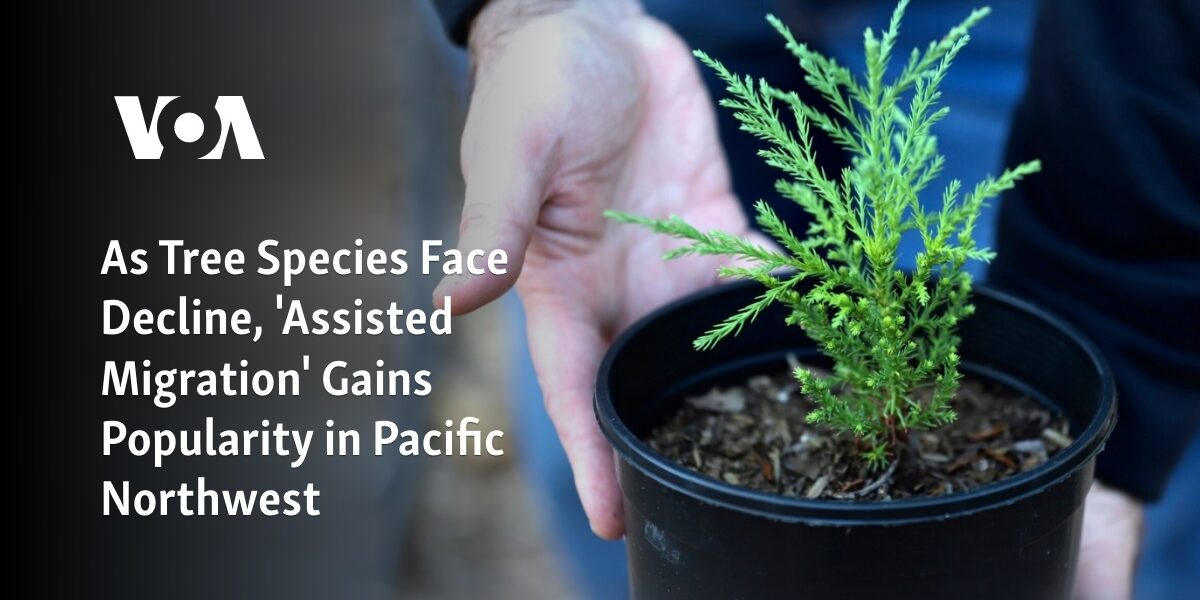As the number of tree species in decline increases, the practice of ‘assisted migration’ is becoming more popular in the Pacific Northwest region.
 portland, oregon —
portland, oregon —
Due to the effects of climate change, native trees in the Pacific Northwest are perishing. In response, the U.S. Forest Service, the city of Portland, Oregon, and various citizen organizations in the Puget Sound area are implementing a seemingly straightforward approach to adapt to these changes, known as “assisted migration.”
As global temperatures rise, it is expected that the areas where trees can grow in the Northern Hemisphere will shift further north and to higher elevations.
Assisted migration is intended to help trees relocate to new climatic environments, as they are unable to move on their own.
The concept is that people can assist trees in adapting to climate change by relocating them to more suitable environments at a faster pace than their natural migration.
There is disagreement about the specific type of assisted migration required for the area, and whether it is always beneficial.
There is a growing divide in the Pacific Northwest between those who support assisted migration to aid struggling native trees, and those who propose replacing native species with trees from the southern region, such as coast redwoods and giant sequoias.
Michael Case, a forest ecologist at the Nature Conservancy in Virginia, stated that there is a significant distinction between aiding in the movement of human populations and aiding in the movement of species.
At the Conservancy’s Ellsworth Creek Preserve in western Washington, Case is currently conducting an experiment to assist with population migration.
Assisted population migration involves moving a native species’ seeds, and by extension its genes, within its current growing range.
On the other hand, assisted species migration entails relocating a species far from its current habitat, for example, bringing in redwoods and sequoias to Washington.
Another form of assisted migration, known as “range expansion,” involves relocating a species slightly beyond its current habitat range.
Case is conducting a project to investigate the viability of utilizing breeds of local Douglas fir and western hemlock from the drier regions of the Pacific Northwest to aid in the adaptation of western Washington forests to changing climate conditions. He explains that the Nature Conservancy is prioritizing population migration due to its lower ecological risks.
According to Case, planting in an area where a certain species is not native can raise the chances of failure. This can also disrupt the natural functions and processes of the ecosystem.
According to Dr. David Lytle, the deputy chief for research and development at the Forest Service, the only type of assisted migration currently in use nationwide is population migration.
Lytle stated that they are extremely careful and do not participate in the transportation or introduction of plant material outside of the historical range of a species.
The Forest Service is implementing assisted population migration as it is expected to have minimal or no adverse effects on ecosystems, according to the official.
Professor Douglas Tallamy from the University of Delaware, who specializes in entomology and wildlife ecology, stated that one potential drawback of species migration is the chance that native caterpillars may no longer consume the leaves of nonnative tree species that have migrated. This could have a ripple effect on the food chain, as caterpillars are an important food source for birds and other animals.
According to Tallamy, this scenario could occur if the City of Portland introduces oak species from southern regions.
According to him, oaks play a critical role in supporting wildlife in North America. However, when they are relocated, the animals that rely on them for food are unable to reach them.
The Urban Forestry program in Portland is currently conducting a trial of assisted migration for 11 types of trees, specifically three species of oak that will be relocated to the southern region: California black oak, canyon live oak, and interior live oak.
In response to an email inquiry about potential ecological disruptions, Jenn Cairo, Portland’s City Forester & Urban Forestry Manager, stated that they utilize information from universities, state and federal agencies, as well as the expertise of local and regional field practitioners.
PropagationNation, a citizen-led group in Puget Sound, supports species migration by planting trees in Seattle parks. Their website states their goal of bringing a million coast redwoods and giant sequoias to the Northwest.
The PropagationNation website suggests planting redwoods in regions where there are already native species such as western red cedar, western hemlock, Sitka spruce, and big leaf maple.
In recent years, climate-related events have caused the death and reduced growth of western red cedar, western hemlock, and big leaf maple.
The founder and president of PropagationNation, Philip Stielstra, who is also a former employee of Boeing, chose not to provide a comment for this article.
According to David Milarch, the creator of Archangel Ancient Tree Archive in Michigan, who has provided PropagationNation with redwood and sequoia trees, his goal is not to replace native species in the Pacific Northwest.
Milarch stated that their efforts involve expanding the territory of redwoods and sequoias to the north, with the goal of preserving them for the next 100 to 200 years and preventing them from becoming another addition to the list of endangered trees.
This article is a result of a partnership between The Associated Press and Columbia Insight, studying the influence of climate on trees in the Pacific Northwest.
Source: voanews.com




